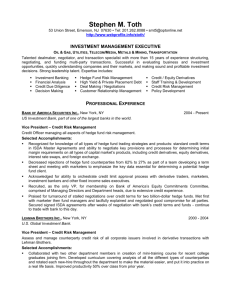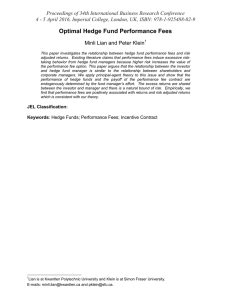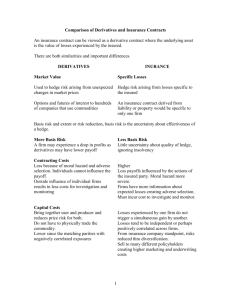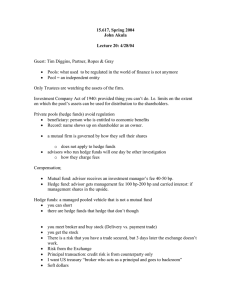Hedge Funds Stumble Even When Walking; 'Conservative' Wagers Turn Sour,
advertisement
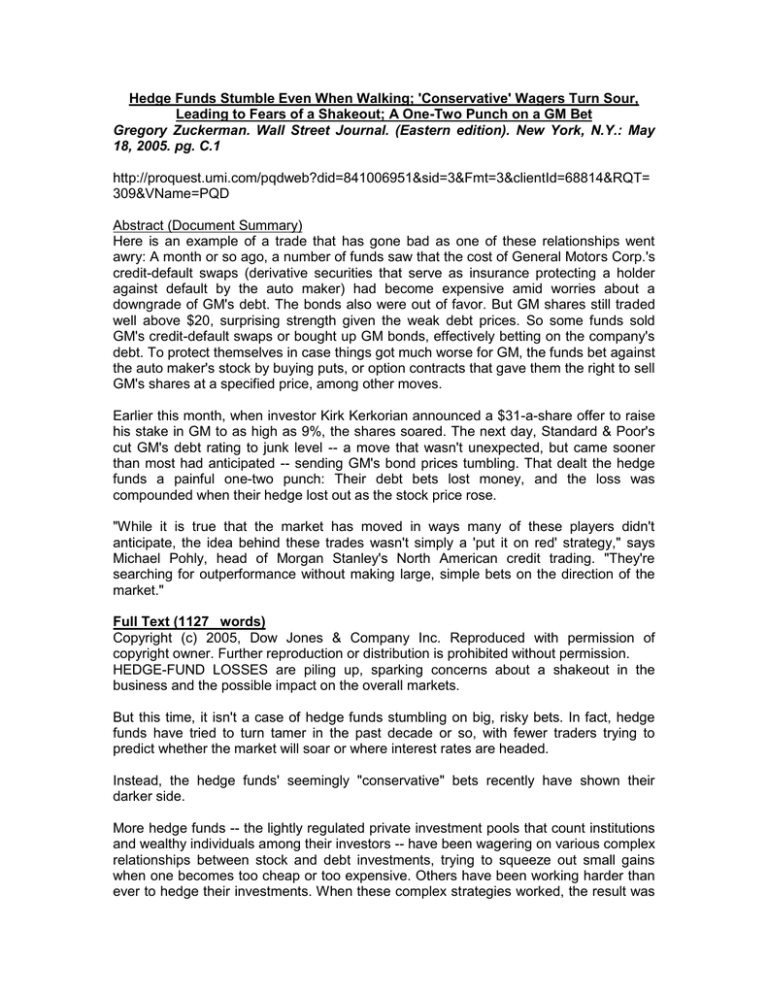
Hedge Funds Stumble Even When Walking; 'Conservative' Wagers Turn Sour, Leading to Fears of a Shakeout; A One-Two Punch on a GM Bet Gregory Zuckerman. Wall Street Journal. (Eastern edition). New York, N.Y.: May 18, 2005. pg. C.1 http://proquest.umi.com/pqdweb?did=841006951&sid=3&Fmt=3&clientId=68814&RQT= 309&VName=PQD Abstract (Document Summary) Here is an example of a trade that has gone bad as one of these relationships went awry: A month or so ago, a number of funds saw that the cost of General Motors Corp.'s credit-default swaps (derivative securities that serve as insurance protecting a holder against default by the auto maker) had become expensive amid worries about a downgrade of GM's debt. The bonds also were out of favor. But GM shares still traded well above $20, surprising strength given the weak debt prices. So some funds sold GM's credit-default swaps or bought up GM bonds, effectively betting on the company's debt. To protect themselves in case things got much worse for GM, the funds bet against the auto maker's stock by buying puts, or option contracts that gave them the right to sell GM's shares at a specified price, among other moves. Earlier this month, when investor Kirk Kerkorian announced a $31-a-share offer to raise his stake in GM to as high as 9%, the shares soared. The next day, Standard & Poor's cut GM's debt rating to junk level -- a move that wasn't unexpected, but came sooner than most had anticipated -- sending GM's bond prices tumbling. That dealt the hedge funds a painful one-two punch: Their debt bets lost money, and the loss was compounded when their hedge lost out as the stock price rose. "While it is true that the market has moved in ways many of these players didn't anticipate, the idea behind these trades wasn't simply a 'put it on red' strategy," says Michael Pohly, head of Morgan Stanley's North American credit trading. "They're searching for outperformance without making large, simple bets on the direction of the market." Full Text (1127 words) Copyright (c) 2005, Dow Jones & Company Inc. Reproduced with permission of copyright owner. Further reproduction or distribution is prohibited without permission. HEDGE-FUND LOSSES are piling up, sparking concerns about a shakeout in the business and the possible impact on the overall markets. But this time, it isn't a case of hedge funds stumbling on big, risky bets. In fact, hedge funds have tried to turn tamer in the past decade or so, with fewer traders trying to predict whether the market will soar or where interest rates are headed. Instead, the hedge funds' seemingly "conservative" bets recently have shown their darker side. More hedge funds -- the lightly regulated private investment pools that count institutions and wealthy individuals among their investors -- have been wagering on various complex relationships between stock and debt investments, trying to squeeze out small gains when one becomes too cheap or too expensive. Others have been working harder than ever to hedge their investments. When these complex strategies worked, the result was lower volatility for hedge-fund returns and a surge of interest from institutional investors fed up with the ups and downs of the stock and bond markets. What went wrong? Some hedge funds got burned because their hedging assumptions failed to pan out, causing deep losses. Too many funds used similar strategies, such as convertible-bond trading, and now find they can't exit losing trades without disrupting the market. All this has led to hedge-fund losses of about 1.5% so far this year. Some strategies are down much more -- funds that focus on convertible bonds, for instance, have lost more than 6%. Such jolting losses could also cut into the often-hefty fees, typically a percentage of assets as well as of investment gains, collected by the funds from their investors. While some hedge funds, including so-called macro funds and those that focus on commodities, still bet on big market moves, more have returned to the tack that gave hedge funds their name more than five decades ago. The recent problems, however, are a painful reminder of how difficult it is to properly hedge large, dynamic investment portfolios. "You get consistent 6% or so returns by not betting on the market, but rather on relationships in the market," says James Bianco, president of Bianco Research LLC in Chicago. But since many hedge funds and their investors use leverage, or borrowed money, gains -- and losses -- are amplified. And the losses can be unexpected: rather than a big market tumble, an odd shift in the correlations between certain stock and debt prices increasingly can surprise traders. Here is an example of a trade that has gone bad as one of these relationships went awry: A month or so ago, a number of funds saw that the cost of General Motors Corp.'s credit-default swaps (derivative securities that serve as insurance protecting a holder against default by the auto maker) had become expensive amid worries about a downgrade of GM's debt. The bonds also were out of favor. But GM shares still traded well above $20, surprising strength given the weak debt prices. So some funds sold GM's credit-default swaps or bought up GM bonds, effectively betting on the company's debt. To protect themselves in case things got much worse for GM, the funds bet against the auto maker's stock by buying puts, or option contracts that gave them the right to sell GM's shares at a specified price, among other moves. But earlier this month, when investor Kirk Kerkorian announced a $31-a-share offer to raise his stake in GM to as high as 9%, the shares soared. The next day, Standard & Poor's cut GM's debt rating to junk level -- a move that wasn't unexpected, but came sooner than most had anticipated -- sending GM's bond prices tumbling. That dealt the hedge funds a painful one-two punch: Their debt bets lost money, and the loss was compounded when their hedge lost out as the stock price rose. Recent deep losses in the world of credit trading also resulted from apparently safe twosided trades that went awry, rather than gunslinging. Many funds have been buying up the riskiest slice of certain collateralized-debt obligations, or CDOs. These are pools of corporate debt or derivatives from various companies that are repackaged into slices with varying levels of risk and yields. The riskiest slice, which figures to get hurt the most if companies begin to default on the underlying debt, also had the best returns, rewarding the hedge funds. But the funds didn't want to be caught short in a downturn in the economy, so they hedged themselves by betting against slightly less-risky tranches of these CDOs, which would fall in value if a rash of defaults arose. Usually these two CDO slices are closely correlated. But when GM and Ford Motor Co. were downgraded by S&P, the riskiest CDO slices took it on the chin, while the safer CDO slices shrugged it off. As a result, hedge funds making this "correlation trade" sustained heavy losses of as much as 12% in April alone, according to Merrill Lynch. In convertibles, the problem has been that hedge funds misjudged how the convertible market would react in a downturn. As some funds moved to trim their losses by selling convertible bonds, which convert into shares of a company at a preset price, other funds with similar strategies raced for the exits, worried that their own investors would get skittish and redeem their investments. "While it is true that the market has moved in ways many of these players didn't anticipate, the idea behind these trades wasn't simply a 'put it on red' strategy," says Michael Pohly, head of Morgan Stanley's North American credit trading. "They're searching for outperformance without making large, simple bets on the direction of the market." This all may sound a bit familiar. Long-Term Capital Management, the giant hedge fund that had to be rescued by Wall Street firms in 1998, sending shudders throughout the market, specialized in buying certain bonds while betting against others. After Russia defaulted on its debt in the fall of that year, all kinds of riskier debt that LTCM was betting on fell in value, causing losses, while the price of investments like U.S. Treasurys that LTCM was betting against as a hedge jumped, adding to the losses. While few hedge funds use the same amount of leverage as LTCM, today there are many more funds and traders at Wall Street banks chasing other relative-value strategies, leading to hand-wringing in the market. A big concern: If too many hedge-fund investors ask for their money back on the heels of the recent disappointing performance, it could force more funds to sell investments to raise cash. Some funds already have dumped investments, however, anticipating redemptions from investors at the end of the second quarter, when many funds allow investors to exit their funds.

